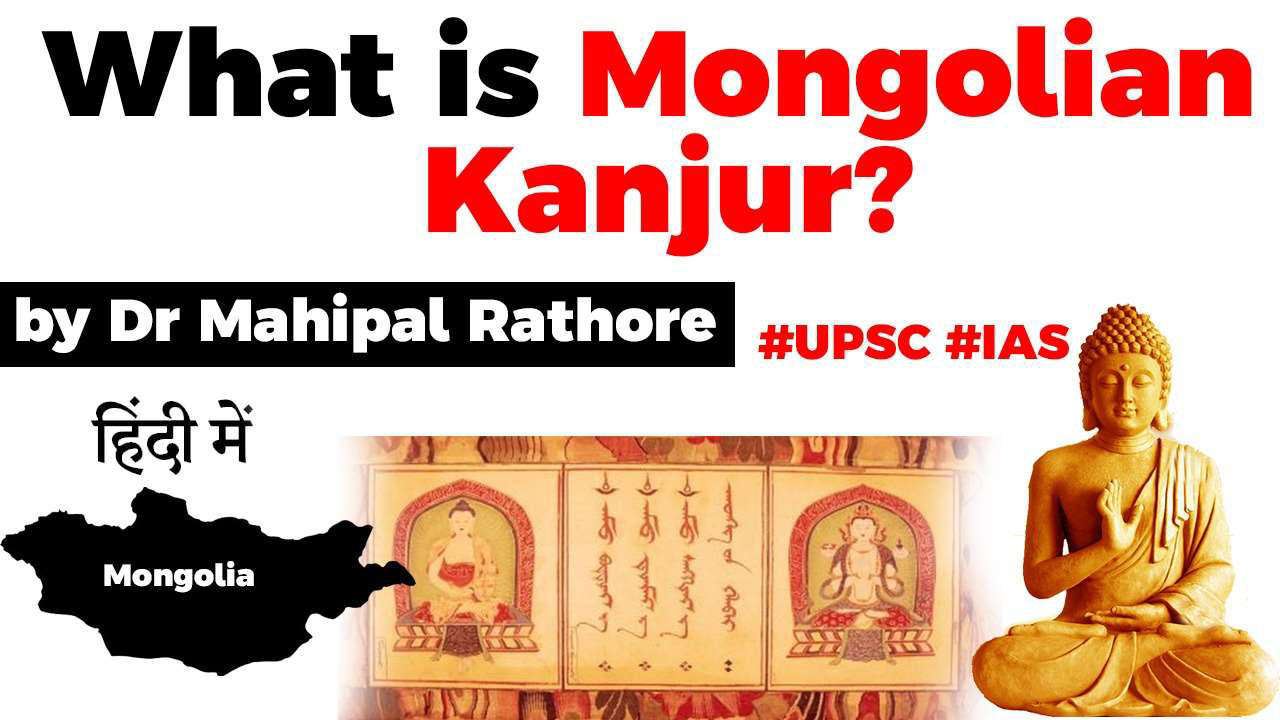Table of Contents

- On 4th July 2020, the first set of five volumes of Mongolian Kanjurpublished under the NMM was presented to the President of India on the occasion of Guru Purnima, also known as (Dharma Chakra Day)


The Project
- The Ministry of Culture has taken up the project of reprintingof 108 volumes of Mongolian Kanjur under the National Mission for Manuscripts (NMM).
- It is expected that all the 108 volumes of the Mongolian Kanjur will be published by March, 2022.

What is Kanjur?
- Mongolian Kanjur is the Buddhist canonical text , considered to be the most important religious text in Mongolia.
- In the Mongolian language ‘Kanjur’ means ‘Concise Orders’-the words of Lord Buddha in particular.
- The language of the Kanjur is Classical Mongolian.
- There are 108 volumes
- It is held in high esteemby the Mongolian Buddhists and they worship the Kanjur at temples and recite the lines of Kanjur in daily life as a sacred ritual.
- The Kanjur are kept almost in every monastery in Mongolia.
- The works have been translated from Tibetan. (Kangyur)
- The Mongolian Kanjur is a source of providing a cultural identity to Mongolia.

India and Mongolia
- Historical interaction between India and Mongolia goes back centuries.
- Buddhism wascarried to Mongolia by Indian cultural and religious ambassadorsduring early part of 1stmillennium
- Traditionally,Tibetan Buddhismwas the predominant religion.
- However, it was suppressed under the communist regime (1946-1990), with only one showcase monastery allowed to remain. Many manuscripts were consigned to flames and monasteries were bereft of their sacred scriptures.
- Since 1990, as liberalization began, Buddhism has encountered a resurgence.
- According to the national census of 2010, 53% of the Mongolians identify as Buddhists.
Indian Connection
- During 1956-58, Professor Raghu Vira obtained a microfilm copy of the rare Kanjur manuscripts and brought them to India.
- Mongolian Kanjur in 108 volumes was published in India in 1970s by Prof. Lokesh Chandra, former Rajya Sabha MP.
- Now, the present edition is being published by the National Mission for Manuscripts, in whichevery volume will have a list of contents indicating the original title of the sutra in Mongolian.
- India established formaldiplomatic relationswith Mongolia in 1955.
- Since then, the overwhelming relationship between both the countries has now reached a new height.
- A set of the 5 reprinted volumes was also handed over tothe Ambassador of Mongolia by Indian Govt.
Soft power
- The publication of Mongolian Kanjur by the Government of India for the Government of Mongolia will act as a symbol of cultural symphony between India and Mongolia and will contribute to furtherance of bilateral relations during the coming years.
What is a Manuscript ?
- Amanuscriptis a handwritten composition on paper, bark, cloth, metal, palm leaf or any other material dating back at least seventy-five years that has significant scientific, historical or aesthetic value.
- Lithographs and printed volumes are not manuscripts.
- Epigraphs on rocks, revenue records ?
National Mission for Manuscripts
- The National Mission for Manuscripts was launched in February 2003 by the Government of India, under the Ministry of Tourism and Culture
- Mandate -documenting, conserving and disseminating the knowledge preserved in the manuscripts.
- To publish rare and unpublished manuscripts so that the knowledge enshrined in them is spread to researchers, scholars and general public at large.
- India possesses an estimate of five million manuscripts, probably the largest collection in the world.
- These cover a variety of themes, textures and aesthetics, scripts, languages, calligraphies, illuminations and illustrations.
- Together, they constitute the ‘memory’ of India’s history, heritage and thought.
- These manuscripts lie scattered across the country and beyond, in numerous institutions as well as private collections, often unattended and undocumented.
- The National Mission for Manuscripts aims to locate, document, preserve and render these accessible—to connect India’s past with its future, its memory with its aspirations.
Latest Burning Issues | Free PDF






















 WhatsApp
WhatsApp